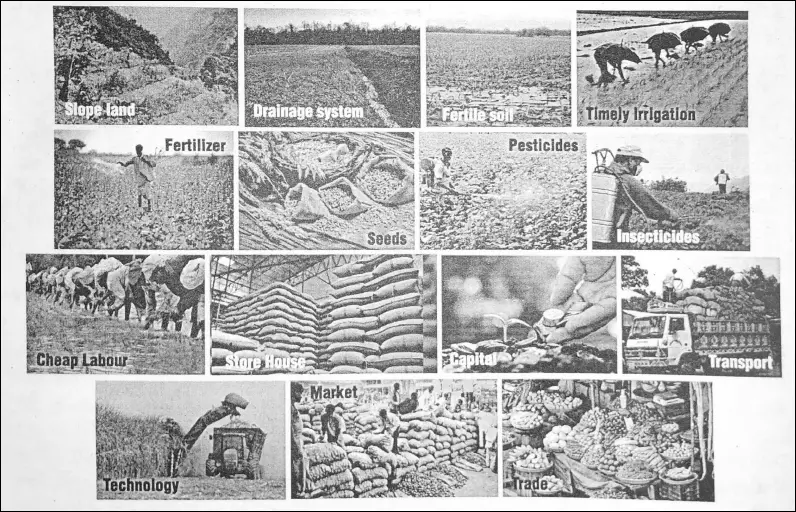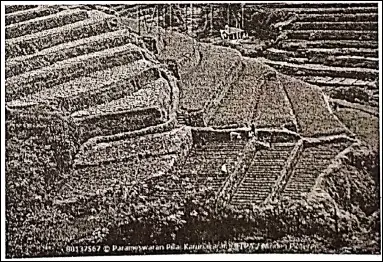Chapter 10 India – Agriculture Of India Introduction :
India is an agricultural country. In India, agriculture plays an important role in dominating the economic, social, and cultural life of the people. Agriculture is the principal occupation of the people of India.
More than 70% of the working population maintains their livelihood by cultivation. Agriculture also provides about 50% of India’s national income. The agricultural sector in India contributes about 16% of G.D.P. (Gross Domestic Products) and 10% of export earnings.
India’s agriculture mainly depends on monsoonal rainfall. This rainfall is uneven and irregular. So, in India agriculture is influenced by the availability of proper irrigational facilities.
Read and Learn More WBBSE Notes For Class 6 Junior School Geography
Essential elements for agriculture :
There are certain essential elements for effective agriculture which are as follows :
(1) Relief or slope of the land.
(2) Proper Drainage system.
(3) Fertile Soil.
(4) Proper and timely Irrigation.
(5) Fertilizer.
(6) High-yielding seeds.
(7) Pesticides.
(8) Insecticides.
(9) Cheap Labour.
(10) Storehouse.
(11) Capital.
(12) Transport.
(13) Technology.
(14) Market.
(15) Trade and Commerce.

Green Revolution :
The profuse increase in agricultural produce by the use of modern agricultural methods and infrastructure was known as the ‘Green Revolution. In the backdrop of the food crisis that gripped India in the 1960s and 1970s, the government of India initiated the ‘Green Revolution program.
This was an attempt to become self-sufficient in the production of food grain. Instead of the traditional method, farming with chemical fertilizer, high-yielding seeds, pesticides, irrigation, and advanced technologies was introduced.
Impact of Green Revolution :
- It helps to an expansion of agricultural land.
- Due to this our country became self-sufficient in foodgrain production.
- Import of foodgrains has been reduced.
- Mechanisation of agriculture has increased.
- Many agro-based industries have been set up.
- It also increases the standard of living of the people.
Types of Agricultural, crops :
India is a vast country with a variety of relief, climate, and soil conditions. Therefore a large variety of crops are grown all over the country. The great variety of crops that are grown in India may be broadly divided into the following types of crops on the basis of their uses;
(1) Food crops
(2) Fibrous crops
(3) Vegetable crops
(4) Beverage crops
(5) Other crops.
(1) Food Crops :
The crops that are grown with nutrients in the diet and consumed or eaten by humans and animals are known as ‘food crops’. These are paddy (rice), wheat, maize, and millets (jowar, bajra, ragi, etc.)
(2) Fibrous Crops :
Crops from which ‘yarn’ is produced are known as ‘fibrous crops’. Cotton, jute, mesta, hemp etc. are the examples of fibrous crops.
(3) Vegetable Crops :
Variety of vegetables are- Potato, tomato, brinjal, beet etc.
(4) Beverage Crops :
These are used as drinking purposes. Tea, coffee, etc. are examples of beverage crops.
(5) Other Crops :
Among other crops oilseeds, (mustard, rapeseed, sesame seed, castor seed, linseed, groundnut, coconut, etc.), various spices, and fruits, are important. On the basis of seasons, India has the following cropping seasons, namely -‘Kharif’ and ‘Rabi’ crops.
Kharif Crops :
Crops cultivated in the beginning of the rainy season and harvested in the end of autumn (September-October) are known as ‘Kharif Crops’. Important kharif crops are-‘Aman’ paddy, cotton, jute, sugarcane, millets, corn, and groundnut.
Rabi Crops :
Crops cultivated in the beginning of the winter or late autumn and harvested in the spring or beginning of the summer are known as ‘Rabi Crops’. Some important rabi crops are wheat, barley, potato, pulses, linseed, and mustard.
Distinguish Between ‘Kharif Crops’ And ‘Rabi Crops’ :
| Kharif crops | Rabl crops |
| 1. Crops sown soon after the onset of the South-West monsoon and harvested in Autumn. | 1. Crops sown in India in winter and harvested in spring. |
| 2. These are grown after the rains in June-July. | 2. These crops are grown in October-December. |
| 3. Kharif season has monsoon or summer crops. | 3. Rabi season has winter crops. |
| 4. Rice (paddy), maize, millets, cotton, jute, and sugarcane are Kharif crops. | 4. Wheat, barley, oilseeds, pulses, potato, etc. |
Cash Crops :
The crops which are grown, harvested, and sold to earn money, particularly the foreign exchange are known as ‘Cash Crops’. These crops are grown for each rather than for sustenance.
These are used as industrial and trading purposes. Jute, Cotton, etc. are the main cash crops in India. Sugarcane, oilseeds, rubber, etc. are also important cash crops in India.
Special Methods Of Cultivation :
Jhum Cultivation :
The primitive method of ‘slash and burn’ or jhooming (jhum cultivation) is practiced in the states of north-eastern hilly areas by tribal people. By this process, a small place of land is cleared by burning trees and cultivated for 3-4 years after which they shift to another place and cultivate in a similar way.
So, it is a type of ‘shifting cultivation’. As a result, the forest is destroyed and soil erosion takes place rapidly. So, it is indispensable to stop jhoom cultivation to prevent soil erosion.

Terrace Cultivation :
The method of cultivation in hilly areas by making steps on slopes to prevent soil erosion is called ‘Terrace cultivation.

WBBSE Notes for Class 6 Junior School Geography
- Chapter 1 The Universe and Solar System
- Chapter 2 Shape of The Earth: Is The Earth Around?
- Chapter 3 Location of a Place on The Earth’ Surface: Where You Are
- Chapter 4 The Earth’s Motion: The Earth Rotation
- Chapter 5 Water – Land – Air
- Chapter 6 The Ice Capped Continent: Antartica
- Chapter 7 Weather And Climate
- Chapter 8 Air Pollution
- Chapter 9 Noise Pollution
- Chapter 10 India

